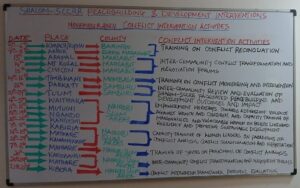
Approaching Loyangalani Town. The scenic town located right next to Lake Turkana.
By Godfrey Okoth
The journey of conflict intervention in Loiyangalani and Mt. Kulal in Marsabit County started in October 2015 with a bold invitation from the Diocese of Marsabit and influential opinion shapers to SCCRR to bring their expertise in conflict transformation to this area. It was a time when the Samburu and Turkana communities living in Loiyangalani Sub-county could not see eye to eye because of heightened competition over water resources and grazing fields which prompted rampant interethnic killings and cattle raids. Moreover, the establishment of the massive Lake Turkana wind power project, appeared to complicate the already injured relationship since it brought into play the competition for employment opportunities between the Turkana and the Samburu who are the main inhabitants in the area where the project is established.

Women from the Samburu, Turkana and Rendille communities following the discussion during the community dialogue session in Sarima. With them is the retired chief of Sarima
The intervention of Shalom into the Samburu-Turkana conflict in Loiyangalani was marked by mixed reactions with some showing optimism that the efforts would bear fruit but others showing scepticism by expressing doubt that the deep seated hatred between the communities would never change. In the first workshop held in Loiyangalani in October 2015, the total absence of members from the Samburu community was alarming. On the other hand, at Mt. Kulal where SCCRR met the Samburu community at a workshop, very bitter statements from a section of participants from the Samburu community openly declared that if it were not for the coming of Shalom, there was a plan in place to go and attack the Turkana in Loiyangalani in less than a weeks’ time.
Since then however, great strides have been made towards guiding the two rival communities to draw closer to each other through the skilful guidance that has been offered by SCCRR staff for the past one year. SCCRR first began by mobilising the two communities separately to appoint selected influential community leaders to form peace committees that would work on behalf of their respective communities in addressing actual or latent conflict situations in Loiyangalani sub-county. This led to the establishment of Loiyangalani Shalom Peace Committee (LSPC) in November 2015 and the Mt. Kulal Shalom Peace Committee (MKSPC) in the same month. SCCRR then engaged the peace committees in intensive trainings on Conflict Mapping, Conflict Early Warning and Conflict Mediation to enhance their analysis and understanding of the nature, context and dynamics of the Turkana-Samburu conflict as a basis for intervention. These interventions took into account the empirical research conducted by SCCRR under the direction of Professor Wanakayi K. Omoka. Alongside the trainings, the peace committees held meetings locally once every 2 weeks to brief each other and their respective communities on the security situation as well as to mobilise peaceful responses whenever there were actual or latent cases of cattle theft. This has led to a considerable reduction in cases of livestock theft and interethnic attacks between the two communities in the past year. Furthermore, in 80% of the cases where actual raids occurred, the peace committees managed to facilitate the return of all the stolen animals.
It is however worth noting that the peace efforts of the two separate peace committees had not trickled much to the communities in order to be able to help mend the broken relationship between the Turkana and Samburu. The lack of meaningful relationship between the two communities triggered interest among the peace committee members to initiate forums which can bring them together. This led to the proposal to have an interethnic dialogue meeting focusing on root causes and materialised and was held on 8th October 2016 at Sarima in Loiyangalani Sub County. The meeting that was the first of its kind since the year 2009 brought together 35 influential community leaders drawn from among the Turkana, Samburu, Rendille and El-Molo living in Loiyangalani sub-county. Other than creating relationship between the communities, the leaders came together to discuss the current conflict situation and establish the way forward for working together for peace as communities that living together. While expressing the benefits of the dialogue to the communities, Lentaawa Paul, a Samburu elder from Mt. Kulal observed that the dialogue will help to create greater freedom of interaction and enhance communication between communities thus help to facilitate better information sharing for conflict intervention.

A group photo of the community leaders who attended the community dialogue workshop in Sarima
The meeting identified 5 action points for change which will be key areas of focus in future interventions. These were: 1.To increase frequency of interethnic meetings; 2.To fast track the participation of the warriors in conflict intervention; 3.To form a joint communal peace committee that comprises of leaders from the entire sub-county; 4.To fast track communication and information sharing between leaders from all the communities; 5.To hold joint awareness creation sessions with a view of emphasizing the value of peaceful co-existence.
The onset of the communal dialogue between these historic rivals opens a chapter of optimism in the relationship between the Turkana and Samburu in Loiyangalani since it carries with it the hope of not only sharing information about a possible conflict but also providing an opportunity to restore the long lost relationship between the rival communities. Through the ready support from the local community leadership and the expertise from SCCRR, the hope of attaining positive peace in Loiyangalani is no longer elusive.

